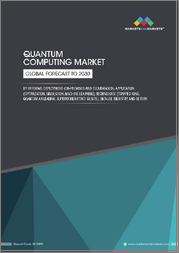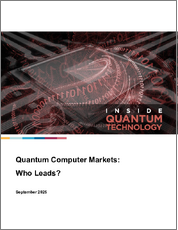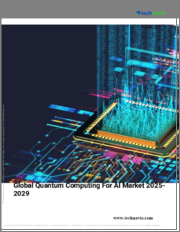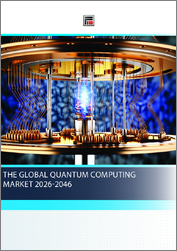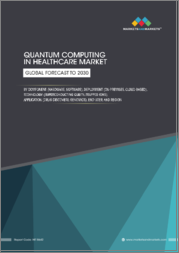
|
시장보고서
상품코드
1715795
양자 컴퓨팅 시장 : 기술 유형, 제공, 배포 모델, 애플리케이션, 업계별 - 세계 예측(2025-2030년)Quantum Computing Market by Technology Types, Offering, Deployment Models, Applications, Industry Verticals - Global Forecast 2025-2030 |
||||||
양자 컴퓨팅 시장은 2024년에 15억 1,000만 달러로 평가되며, 2025년에는 18억 6,000만 달러, CAGR 24.23%로 성장하며, 2030년에는 55억 8,000만 달러에 달할 것으로 예측됩니다.
소개
| 주요 시장 통계 | |
|---|---|
| 기준 연도 2024년 | 15억 1,000만 달러 |
| 예상 연도 2025년 | 18억 6,000만 달러 |
| 예측연도 2030 | 55억 8,000만 달러 |
| CAGR(%) | 24.23% |
양자 컴퓨팅은 복잡한 계산 문제를 해결하는 방식에 큰 변화를 가져오고 있습니다. 이 새로운 분야는 양자 역학의 원리를 이용하여 기존의 컴퓨팅 아키텍처로는 해결하기 어려운 문제를 해결합니다. 지난 수년간 양자 컴퓨팅은 이론적 연구에서 실용적 구현으로 전환하여 다양한 산업 분야에서 혁명적 발전의 토대를 마련했습니다. 양자컴퓨팅의 발전은 하드웨어 기술의 급속한 발전과 중첩 및 얽힘 현상을 이용한 첨단 양자 알고리즘의 개발로 특징지어집니다. 전 세계 기업은 양자 연구에 투자하는 한편, 새로운 양자 솔루션을 적용하고 확장하기 위한 전략적 프레임워크를 구축하고 있습니다. 학계, 기술 리더, 정부 기관이 혁신을 주도하는 생태계가 확대됨에 따라 양자 컴퓨팅은 미래 디지털 인프라의 초석이 될 것으로 예측됩니다. 이 보고서는 시장의 변화, 세분화에 대한 미묘한 인사이트, 지역적 차이, 주요 기업의 참여를 통해 양자 컴퓨팅의 역동적인 상황을 살펴봅니다. 양자 기술의 변화 가능성을 이해하고 활용하고자 하는 의사결정권자를 위한 종합적인 개요를 제공합니다.
양자 컴퓨팅 시장의 변화
양자컴퓨팅은 경쟁 구도를 재정의하고 혁신의 새로운 길을 열어주는 변혁의 시기를 맞이하고 있습니다. 최근 양자 하드웨어, 알고리즘 개발, 오류 수정의 발전으로 실용적이고 확장 가능한 시스템의 실현에 가까워지고 있습니다. 기존 컴퓨팅 패러다임은 최적화, 암호화, 복잡한 시뮬레이션과 같은 작업에서 비약적인 속도 향상을 약속하는 양자 접근 방식으로 전환되고 있습니다. 이러한 변화의 과정은 정부의 대규모 자금 지원, 민간 투자, 국경을 초월한 공동 연구 구상에 의해 지원되고 있습니다. 많은 이해관계자들이 양자 기술을 통합하기 위해 비즈니스 모델을 조정하기 시작했으며, 기존 기업과 민첩한 스타트업이 모두 번창할 수 있는 환경이 조성되고 있습니다. 연구와 응용의 융합은 기술의 도약뿐만 아니라 세계 시장 전략과 규제 프레임워크의 변화를 의미하기도 합니다. 기업은 양자역학의 획기적인 발전을 활용하기 위해 스스로의 포지셔닝을 바꾸고 있으며, 정책 입안자들은 안전하고 윤리적인 활용을 보장하기 위한 프레임워크를 검토하기 시작했습니다. 이러한 상황은 역동적이며, 기존의 이해를 뒤집고 미지의 영역으로 업계를 밀어붙이는 업데이트가 계속되고 있습니다.
주요 세분화
양자 컴퓨팅 시장을 이해하려면 혁신과 응용의 다양한 분야를 반영하는 여러 가지 세분화 계층을 미묘하게 탐색해야 합니다. 시장 세분화는 먼저 양자 어닐링, 초전도 양자 비트, 토폴로지 접근법, 광학적 접근법, 트랩드 이온 등 기술 유형에 따라 세분화됩니다. 이러한 다양한 연구 방법은 풍부한 연구 경로와 특정 과제에 적합한 다양한 성능 프로파일을 제공합니다. 서비스에서는 컨설팅 서비스, 유지보수, 지원, 서비스형 양자(Quantum-as-a-Service)와 같은 모델이 있으며, 소프트웨어에서는 양자 알고리즘, 양자 프로그래밍 언어, 양자 상태 시뮬레이터로 분류됩니다. 이 외에도 도입 모델은 클라우드 기반과 온프레미스 솔루션으로 분류됩니다. 용도별 세분화에서는 양자키 분배 및 보안 통신을 포함한 암호화, 머신러닝, 산업 최적화 및 공급망 관리가 중요한 역할을 하는 최적화, 분자 시뮬레이션 및 일기예보를 포함한 시뮬레이션 등 중요한 분야가 강조되고 있습니다. 마지막으로 자동차, 화학 산업, 에너지/전력, 금융서비스, 헬스케어/제약, 정보기술, 우주/방위 등 산업별로는 자동차 분야에서는 분자 역학 및 교통관리, 금융서비스 분야에서는 알고리즘 트레이딩 및 포트폴리오 최적화, 헬스케어/제약 분야에서는 신약개발 및 유전체학 등 및 유전체학 등 더욱 세분화되는 모습을 볼 수 있습니다. 이러한 세부적인 세분화 프레임워크는 양자컴퓨팅 생태계의 다양한 용도와 혁신의 원동력을 이해할 수 있는 명확한 경로를 제공합니다.
목차
제1장 서문
제2장 조사 방법
제3장 개요
제4장 시장 개요
제5장 시장 인사이트
- 시장 역학
- 성장 촉진요인
- 성장 억제요인
- 기회
- 해결해야 할 과제
- 시장 세분화 분석
- Porter’s Five Forces 분석
- PESTLE 분석
- 정치
- 경제
- 사회
- 기술
- 법률
- 환경
제6장 양자 컴퓨팅 시장 : 테크놀러지 유형별
- 양자 어닐링
- 초전도 양자 비트
- 트포로지칼 & 포토닉
- 포착된 이온
제7장 양자 컴퓨팅 시장 : 제공별
- 하드웨어
- 서비스
- 컨설팅 서비스
- 정비와 지원
- 양자 서비스
- 소프트웨어
- 양자 알고리즘
- 양자 프로그램 언어
- 양자 상태 시뮬레이터
제8장 양자 컴퓨팅 시장 : 배포 모델별
- 클라우드 기반
- 온프레미스
제9장 양자 컴퓨팅 시장 : 용도별
- 암호화
- 양자 키 분배
- 안전한 통신
- 기계학습
- 최적화
- 산업 최적화
- 공급망 관리
- 시뮬레이션
- 분자 시뮬레이션
- 일기예보
제10장 양자 컴퓨팅 시장 : 업계별
- 자동차
- 분자 동역학
- 교통 관리
- 화학 산업
- 에너지와 전력
- 금융 서비스
- 알고리즘 트레이딩
- 포트폴리오 최적화
- 헬스케어와 의약품
- Drug Discovery
- 유전체학
- 정보기술
- 우주와 방위
제11장 아메리카의 양자 컴퓨팅 시장
- 아르헨티나
- 브라질
- 캐나다
- 멕시코
- 미국
제12장 아시아태평양의 양자 컴퓨팅 시장
- 호주
- 중국
- 인도
- 인도네시아
- 일본
- 말레이시아
- 필리핀
- 싱가포르
- 한국
- 대만
- 태국
- 베트남
제13장 유럽, 중동 및 아프리카의 양자 컴퓨팅 시장
- 덴마크
- 이집트
- 핀란드
- 프랑스
- 독일
- 이스라엘
- 이탈리아
- 네덜란드
- 나이지리아
- 노르웨이
- 폴란드
- 카타르
- 러시아
- 사우디아라비아
- 남아프리카공화국
- 스페인
- 스웨덴
- 스위스
- 튀르키예
- 아랍에미리트
- 영국
제14장 경쟁 구도
- 시장 점유율 분석, 2024
- FPNV 포지셔닝 매트릭스, 2024
- 경쟁 시나리오 분석
- 전략 분석과 제안
기업 리스트
- 1QB Information Technologies Inc.
- Accenture PLC
- Alibaba Group Holding Limited
- Amazon Web Services, Inc.
- Anyon Systems, Inc.
- Arqit Limited
- Atom Computing, Inc.
- Atos SE
- Baidu, Inc.
- Cisco Systems, Inc.
- ColdQuanta, Inc.
- D-Wave Systems Inc.
- Fujitsu Limited
- Google LLC by Alphabet Inc.
- Honeywell International Inc.
- Intel Corporation
- International Business Machines Corporation
- IonQ Inc.
- ISARA Corporation
- Microsoft Corporation
- Nvidia Corporation
- PsiQuantum, Corp.
- QC Ware
- Quantinuum Ltd.
- Quantum Circuits, Inc.
- Quantum Corporation
- Quantum Simulation Technologies, Inc.
- Rigetti & Co, Inc.
- Riverlane Ltd
- Salesforce, Inc.
- Silicon Quantum Computing
- Strangeworks Inc.
- Toshiba Corporation
- Xanadu Quantum Technologies Inc.
- Zapata Computing, Inc.
The Quantum Computing Market was valued at USD 1.51 billion in 2024 and is projected to grow to USD 1.86 billion in 2025, with a CAGR of 24.23%, reaching USD 5.58 billion by 2030.
Introduction
| KEY MARKET STATISTICS | |
|---|---|
| Base Year [2024] | USD 1.51 billion |
| Estimated Year [2025] | USD 1.86 billion |
| Forecast Year [2030] | USD 5.58 billion |
| CAGR (%) | 24.23% |
Quantum computing represents a profound shift in the way we approach complex computational challenges. This emerging field harnesses the principles of quantum mechanics to solve problems that are intractable for traditional computing architectures. Over the past few years, quantum computing has moved from theoretical research to practical implementation, laying the groundwork for revolutionary advancements across multiple industries. The journey of quantum computing is marked by rapid evolution in hardware technologies and the development of sophisticated quantum algorithms that capitalize on phenomena such as superposition and entanglement. As organizations around the globe invest in quantum research, they are also building strategic frameworks to adapt and scale emerging quantum solutions. With a growing ecosystem of academia, technology leaders, and governmental agencies driving innovation, quantum computing is set to become a cornerstone of future digital infrastructure. This summary explores the dynamic landscape of quantum computing through transformative market shifts, nuanced segmentation insights, regional differences, and the involvement of leading companies in the sector. It provides a comprehensive overview tailored for decision-makers seeking to understand and leverage the transformative potential of quantum technologies.
Transformative Shifts in the Landscape
The quantum computing landscape has undergone transformative shifts that redefine competitive dynamics and open up new avenues for innovation. In recent years, advances in quantum hardware, algorithm development, and error correction have moved the field closer to achieving practical and scalable systems. Traditional computing paradigms are giving way to quantum approaches that promise exponential speed-up for tasks like optimization, cryptography, and complex simulations. This transformative process is supported by extensive governmental funding, private investments, and collaborative research initiatives across borders. Many industry stakeholders have started to adapt their business models to integrate quantum technologies, fostering an environment where both established firms and nimble startups can thrive. The convergence of research and application signifies not only technological leaps, but also a shift in market strategies and regulatory frameworks worldwide. Companies are repositioning themselves to take advantage of quantum breakthroughs, while policymakers are beginning to consider frameworks to ensure secure and ethical usage. This landscape is dynamic, with continuous updates that challenge our existing understanding and propel the industry towards uncharted territories.
Key Segmentation Insights
Understanding the quantum computing market requires a nuanced exploration of several segmentation layers, each reflecting different areas of innovation and application. The market is first segmented based on technology types, where it is studied across quantum annealing, superconducting qubits, topological and photonic approaches, as well as trapped ions. These diverse methodologies indicate rich research avenues and varying performance profiles suited to specific tasks. Further segmentation by offering illustrates a market divided into hardware, services, and software; within services, the landscape further unpacks into consulting services, maintenance and support, along with models like Quantum-as-a-Service, while software advancements are classified into quantum algorithms, quantum programming languages, and quantum state simulators. In addition to these, deployment models segregate the market into cloud-based and on-premise solutions - signifying the flexible adoption strategies across organizations. Application-based segmentation highlights critical areas such as cryptography (encompassing quantum key distribution and secure communications), machine learning, optimization - where industrial optimization and supply chain management play crucial roles - and simulations, which include molecular simulation and weather forecasting. Lastly, industry verticals such as automobile, chemical industry, energy and power, financial services, healthcare and pharmaceuticals, information technology, and space and defense provide the final parameters, with further differentiation seen in the automobile sector through molecular dynamics and traffic management, in financial services via algorithmic trading and portfolio optimization, and in healthcare and pharmaceuticals through drug discovery and genomics. This detailed segmentation framework offers a clear path to understanding the diverse application areas and innovation drivers within the quantum computing ecosystem.
Based on Technology Types, market is studied across Quantum Annealing, Superconducting Qubits, Topological & Photonic, and Trapped Ions.
Based on Offering, market is studied across Hardware, Services, and Software. The Services is further studied across Consulting Services, Maintenance & Support, and Quantum-as-a-Service. The Software is further studied across Quantum Algorithms, Quantum Programming Language, and Quantum State Simulators.
Based on Deployment Models, market is studied across Cloud-Based and On-Premise.
Based on Applications, market is studied across Cryptography, Machine Learning, Optimization, and Simulations. The Cryptography is further studied across Quantum Key Distribution and Secure Communications. The Optimization is further studied across Industrial Optimization and Supply Chain Management. The Simulations is further studied across Molecular Simulation and Weather Forecasting.
Based on Industry Verticals, market is studied across Automobile, Chemical Industry, Energy & Power, Financial Services, Healthcare & Pharmaceuticals, Information Technology, and Space & Defense. The Automobile is further studied across Molecular Dynamics and Traffic Management. The Financial Services is further studied across Algorithmic Trading and Portfolio Optimization. The Healthcare & Pharmaceuticals is further studied across Drug Discovery and Genomics.
Key Regional Insights
Regional dynamics play a crucial role in driving the evolution of the quantum computing market. The Americas continue to lead in terms of both technological innovation and significant investment, providing a fertile ground for research and application. Meanwhile, regions spanning Europe, the Middle East, and Africa are advancing policies and nurturing collaborative frameworks that promote cross-border innovation, thereby establishing a strategic balance between regulatory oversight and market freedom. In parallel, the Asia-Pacific region is emerging as a powerhouse fueled by rapid industrial adoption and substantial government backing, which together create a compelling narrative of growth and resilience. Diverse regional strategies reflect how local economic climates, policy environments, and educational infrastructures impact innovation. Decision-makers are increasingly focused on region-specific trends that account for infrastructure readiness, investment climates, and unique market challenges. The interplay between these regions reinforces the global character of quantum computing, highlighting opportunities for strategic partnerships and international collaborations. This multi-regional perspective underscores the need for tailored approaches when entering or expanding within the quantum computing market, where regional specificities influence both technological adoption and market penetration.
Based on Region, market is studied across Americas, Asia-Pacific, and Europe, Middle East & Africa. The Americas is further studied across Argentina, Brazil, Canada, Mexico, and United States. The United States is further studied across California, Florida, Illinois, New York, Ohio, Pennsylvania, and Texas. The Asia-Pacific is further studied across Australia, China, India, Indonesia, Japan, Malaysia, Philippines, Singapore, South Korea, Taiwan, Thailand, and Vietnam. The Europe, Middle East & Africa is further studied across Denmark, Egypt, Finland, France, Germany, Israel, Italy, Netherlands, Nigeria, Norway, Poland, Qatar, Russia, Saudi Arabia, South Africa, Spain, Sweden, Switzerland, Turkey, United Arab Emirates, and United Kingdom.
Key Companies Insights
Leading companies in the quantum computing sector represent an impressive blend of technological prowess and strategic vision. Organizations such as 1QB Information Technologies Inc., Accenture PLC, and Alibaba Group Holding Limited are at the forefront of integrating quantum solutions with classical systems. Giants like Amazon Web Services, Inc., Google LLC by Alphabet Inc., and Microsoft Corporation continue to leverage their extensive cloud infrastructure to drive quantum research forward. Furthermore, specialized players including D-Wave Systems Inc., IonQ Inc., and Rigetti & Co, Inc. are pioneering innovations in quantum hardware and software. The competitive landscape also features significant contributions from Anyon Systems, Inc., Arqit Limited, Atom Computing, Inc., and Atos SE, supplemented by innovations from companies like Baidu, Inc. and Cisco Systems, Inc. This diverse group is further augmented by ColdQuanta, Inc., Fujitsu Limited, Honeywell International Inc., Intel Corporation, International Business Machines Corporation, and emerging leaders such as PsiQuantum, Corp., QC Ware, and Quantinuum Ltd. As the race to achieve viable quantum systems accelerates, additional key players such as Quantum Circuits, Inc., Quantum Corporation, Quantum Simulation Technologies, Inc., Riverlane Ltd, Salesforce, Inc., Silicon Quantum Computing, Strangeworks Inc., Toshiba Corporation, Xanadu Quantum Technologies Inc., and Zapata Computing, Inc. have steadily built their reputations. Their combined efforts illustrate a multifaceted approach to harnessing quantum potential, with each company contributing distinct competencies that further enrich the market's technology, investments, and partnerships.
The report delves into recent significant developments in the Quantum Computing Market, highlighting leading vendors and their innovative profiles. These include 1QB Information Technologies Inc., Accenture PLC, Alibaba Group Holding Limited, Amazon Web Services, Inc., Anyon Systems, Inc., Arqit Limited, Atom Computing, Inc., Atos SE, Baidu, Inc., Cisco Systems, Inc., ColdQuanta, Inc., D-Wave Systems Inc., Fujitsu Limited, Google LLC by Alphabet Inc., Honeywell International Inc., Intel Corporation, International Business Machines Corporation, IonQ Inc., ISARA Corporation, Microsoft Corporation, Nvidia Corporation, PsiQuantum, Corp., QC Ware, Quantinuum Ltd., Quantum Circuits, Inc., Quantum Corporation, Quantum Simulation Technologies, Inc., Rigetti & Co, Inc., Riverlane Ltd, Salesforce, Inc., Silicon Quantum Computing, Strangeworks Inc., Toshiba Corporation, Xanadu Quantum Technologies Inc., and Zapata Computing, Inc.. Actionable Recommendations for Industry Leaders
Industry leaders must adopt a proactive stance in response to the rapid evolution of quantum computing. It is essential to invest in continuous research and development initiatives, forming strategic alliances with academic institutions and technology firms to stay at the cutting edge of innovations. Leaders should consider integrating quantum technologies into pilot projects that target optimization, cryptography, and simulation applications to validate their business models in real-world scenarios. An actionable framework involves reassessing existing IT architecture to identify opportunities for hybrid solutions that merge classical and quantum computing advantages. Decision-makers are advised to closely monitor advancements in key technologies such as superconducting qubits, trapped ions, and topological as well as photonic systems to tailor investment strategies effectively. Furthermore, developing robust cybersecurity measures becomes imperative as quantum technologies introduce both heightened opportunities and risks. To foster organizational agility, companies should prioritize workforce training and upskilling in quantum programming languages and algorithm development. Maintaining a flexible deployment strategy - whether cloud-based or on-premise - can accommodate gradual yet consistent integration of quantum assets. By balancing innovation with measured risk management, industry leaders can position their organizations to capitalize on emerging trends and sustain competitive advantage in an increasingly complex technological landscape.
Conclusion
In summary, the quantum computing market is undergoing dramatic transformation, driven by breakthroughs in quantum theories, hardware innovations, and expanding application domains. The comprehensive segmentation analysis, which covers technology types, offerings, deployment models, applications, and industry verticals, provides valuable insights into the multifaceted nature of the market. Regional dynamics indicate varied approaches, each tailored to local investment climates and policy infrastructures, while the involvement of leading companies further underscores the competitive efforts to harness quantum potential. For decision-makers and industry experts, having a well-rounded perspective on these trends is key to making informed investments and strategic moves. The journey from research and experimentation to practical, scalable solutions is well underway, and businesses now have a unique window of opportunity to influence future developments and drive innovation. This evolving narrative signals that those prepared to embrace the complexities of quantum computing will not only pioneer new technologies but also set the stage for transformative growth in various industrial sectors.
Table of Contents
1. Preface
- 1.1. Objectives of the Study
- 1.2. Market Segmentation & Coverage
- 1.3. Years Considered for the Study
- 1.4. Currency & Pricing
- 1.5. Language
- 1.6. Stakeholders
2. Research Methodology
- 2.1. Define: Research Objective
- 2.2. Determine: Research Design
- 2.3. Prepare: Research Instrument
- 2.4. Collect: Data Source
- 2.5. Analyze: Data Interpretation
- 2.6. Formulate: Data Verification
- 2.7. Publish: Research Report
- 2.8. Repeat: Report Update
3. Executive Summary
4. Market Overview
5. Market Insights
- 5.1. Market Dynamics
- 5.1.1. Drivers
- 5.1.1.1. Growing demand for efficient and secure data processing capabilities
- 5.1.1.2. Increased focus on developing quantum algorithms and softwares
- 5.1.1.3. Rising government funding to strengthen quantum computing research and infrastructure
- 5.1.2. Restraints
- 5.1.2.1. High costs associated with research and development in quantum computing technologies
- 5.1.3. Opportunities
- 5.1.3.1. Integrating quantum computing with artificial intelligence
- 5.1.3.2. Enabling enhanced satellite communication systems and data encryption with quantum mechanics
- 5.1.4. Challenges
- 5.1.4.1. Environmental impact and sustainability concerns from high energy consumption in quantum processing
- 5.1.1. Drivers
- 5.2. Market Segmentation Analysis
- 5.2.1. Technology Types: Rising significance of quantum annealing owing to its optimization capabilities
- 5.2.2. Applications: Expanding application of quantum computing in cryptography for enhancing data security
- 5.3. Porter's Five Forces Analysis
- 5.3.1. Threat of New Entrants
- 5.3.2. Threat of Substitutes
- 5.3.3. Bargaining Power of Customers
- 5.3.4. Bargaining Power of Suppliers
- 5.3.5. Industry Rivalry
- 5.4. PESTLE Analysis
- 5.4.1. Political
- 5.4.2. Economic
- 5.4.3. Social
- 5.4.4. Technological
- 5.4.5. Legal
- 5.4.6. Environmental
6. Quantum Computing Market, by Technology Types
- 6.1. Introduction
- 6.2. Quantum Annealing
- 6.3. Superconducting Qubits
- 6.4. Topological & Photonic
- 6.5. Trapped Ions
7. Quantum Computing Market, by Offering
- 7.1. Introduction
- 7.2. Hardware
- 7.3. Services
- 7.3.1. Consulting Services
- 7.3.2. Maintenance & Support
- 7.3.3. Quantum-as-a-Service
- 7.4. Software
- 7.4.1. Quantum Algorithms
- 7.4.2. Quantum Programming Language
- 7.4.3. Quantum State Simulators
8. Quantum Computing Market, by Deployment Models
- 8.1. Introduction
- 8.2. Cloud-Based
- 8.3. On-Premise
9. Quantum Computing Market, by Applications
- 9.1. Introduction
- 9.2. Cryptography
- 9.2.1. Quantum Key Distribution
- 9.2.2. Secure Communications
- 9.3. Machine Learning
- 9.4. Optimization
- 9.4.1. Industrial Optimization
- 9.4.2. Supply Chain Management
- 9.5. Simulations
- 9.5.1. Molecular Simulation
- 9.5.2. Weather Forecasting
10. Quantum Computing Market, by Industry Verticals
- 10.1. Introduction
- 10.2. Automobile
- 10.2.1. Molecular Dynamics
- 10.2.2. Traffic Management
- 10.3. Chemical Industry
- 10.4. Energy & Power
- 10.5. Financial Services
- 10.5.1. Algorithmic Trading
- 10.5.2. Portfolio Optimization
- 10.6. Healthcare & Pharmaceuticals
- 10.6.1. Drug Discovery
- 10.6.2. Genomics
- 10.7. Information Technology
- 10.8. Space & Defense
11. Americas Quantum Computing Market
- 11.1. Introduction
- 11.2. Argentina
- 11.3. Brazil
- 11.4. Canada
- 11.5. Mexico
- 11.6. United States
12. Asia-Pacific Quantum Computing Market
- 12.1. Introduction
- 12.2. Australia
- 12.3. China
- 12.4. India
- 12.5. Indonesia
- 12.6. Japan
- 12.7. Malaysia
- 12.8. Philippines
- 12.9. Singapore
- 12.10. South Korea
- 12.11. Taiwan
- 12.12. Thailand
- 12.13. Vietnam
13. Europe, Middle East & Africa Quantum Computing Market
- 13.1. Introduction
- 13.2. Denmark
- 13.3. Egypt
- 13.4. Finland
- 13.5. France
- 13.6. Germany
- 13.7. Israel
- 13.8. Italy
- 13.9. Netherlands
- 13.10. Nigeria
- 13.11. Norway
- 13.12. Poland
- 13.13. Qatar
- 13.14. Russia
- 13.15. Saudi Arabia
- 13.16. South Africa
- 13.17. Spain
- 13.18. Sweden
- 13.19. Switzerland
- 13.20. Turkey
- 13.21. United Arab Emirates
- 13.22. United Kingdom
14. Competitive Landscape
- 14.1. Market Share Analysis, 2024
- 14.2. FPNV Positioning Matrix, 2024
- 14.3. Competitive Scenario Analysis
- 14.3.1. D-Wave launches leap quantum launchpad program to accelerate quantum application deployment
- 14.3.2. IBM's release of the Quantum Heron 2 in quantum computing
- 14.3.3. Rescale and IonQ launch partnership to accelerate innovation through hybrid quantum computing
- 14.3.4. Quantinuum gets USD 300 Million from JPMorgan, Amgen, Mitsui, Honeywell
- 14.3.5. IBM Unveils Next-Gen 133-Qubit Heron Quantum Processor and its First Modular Quantum Computer
- 14.4. Strategy Analysis & Recommendation
Companies Mentioned
- 1. 1QB Information Technologies Inc.
- 2. Accenture PLC
- 3. Alibaba Group Holding Limited
- 4. Amazon Web Services, Inc.
- 5. Anyon Systems, Inc.
- 6. Arqit Limited
- 7. Atom Computing, Inc.
- 8. Atos SE
- 9. Baidu, Inc.
- 10. Cisco Systems, Inc.
- 11. ColdQuanta, Inc.
- 12. D-Wave Systems Inc.
- 13. Fujitsu Limited
- 14. Google LLC by Alphabet Inc.
- 15. Honeywell International Inc.
- 16. Intel Corporation
- 17. International Business Machines Corporation
- 18. IonQ Inc.
- 19. ISARA Corporation
- 20. Microsoft Corporation
- 21. Nvidia Corporation
- 22. PsiQuantum, Corp.
- 23. QC Ware
- 24. Quantinuum Ltd.
- 25. Quantum Circuits, Inc.
- 26. Quantum Corporation
- 27. Quantum Simulation Technologies, Inc.
- 28. Rigetti & Co, Inc.
- 29. Riverlane Ltd
- 30. Salesforce, Inc.
- 31. Silicon Quantum Computing
- 32. Strangeworks Inc.
- 33. Toshiba Corporation
- 34. Xanadu Quantum Technologies Inc.
- 35. Zapata Computing, Inc.






